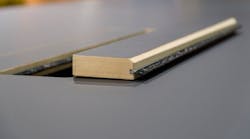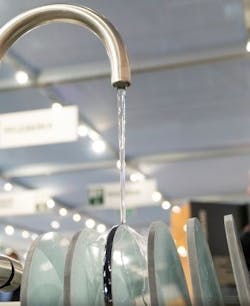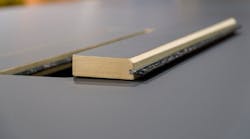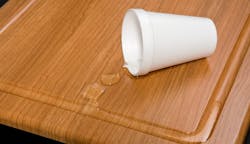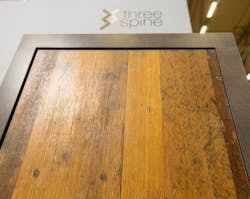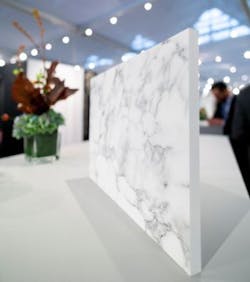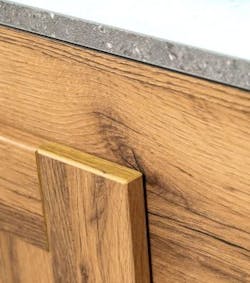Must-Know Facts About Specifying Materials for Furniture, Fixtures and Millwork
Decorative surfaces and components for commercial furniture, fixtures and millwork, as a category, probably include more material options and combinations than any other interior application. While this increases designers’ options for value engineering great visuals without sacrificing performance, safety, and positive climate- and human-health impacts, it can also cause confusion leading to application fails or budget overruns.
This is why, when writing and keynoting your specifications, it’s important to indicate not only the product and supplier, but the unique design and performance characteristics that made it your first choice for each application.
In the case of fixtures and millwork, these materials may also require specialized installation and even on-site finishing. Because there are so many variables, we’re going to set these materials aside for this discussion, except to say that a specifier’s relationships with these suppliers is critical to creating successful commercial solutions.
(Photo: Compact laminates are essentially very thick sheets of HPL with many of the same properties as solid surface materials; Credit: By Kenn Busch, courtesy of Material Intelligence)
Instead, we’ll focus on a category of widely available engineered decorative surfaces that feature universal climate-positive benefits, some common design and material properties, and important differences in performance to match every application. For instance, you don’t need the same level of durability on a feature wall behind the check-in desk as you do in elevator cab, but you can have the same visuals.
The catchall term for this category is “laminates,” although that’s also where some of the confusion comes in because there are so many variations of this material. There are many commonalities and universal properties of engineered decorative surfaces, including:
- Printed decorative surfaces, offering complete control of color and character
- Synchronized (embossed-in-register) textures for impressive realism in woodgrain and other natural designs
- Design-matching programs across materials with different levels of durability and performance
- FSC-certified composite wood substrates that are naturally climate positive (carbon negative)
From the Inside Out: Climate-Positive Substrates
Composite wood panels—particleboard, MDF, hardboard—are used in every commercial project, although they’re rarely called out in specifications unless certain properties are required, like fire or moisture resistance, lighter weight and so on.
All panels manufactured in North America do share one important benefit. They are naturally “climate positive,” meaning they go beyond achieving net zero carbon emissions, creating a measurable environmental benefit by removing more carbon dioxide from the atmosphere than is released in their production.
- Composite wood panels begin life as a recycled product. When trees are harvested for construction lumber, siding and flooring, half of that wood fiber is left over. Composite wood panels use 99% of that leftover wood fiber. The tiny bit still remaining becomes fuel for heating plants and kilns.
- Wood is nature’s perfect carbon sink. Trees absorb carbon from the atmosphere as they grow. Half of the chemical makeup of wood is stored carbon, which isn’t released until it decomposes or burns. Because of the density of wood fiber in composite wood panels, they’ve been documented to store more carbon than is released in their production.
- FSC forestry replaces the natural rhythms of healthy forests. North America’s lumber-producing forests are designed by nature to be healthiest if they are decimated by fire, windfall or insects every 40 years or so. Well-intentioned humans have interrupted these cycles to protect property. Modern FSC forest management restores these cycles by harvesting plots of older trees before they lose their ability to absorb carbon and produce oxygen. The resulting open meadows are perfect for the next generation of young, healthy trees and more attractive birds and animals.
- Lower VOCs than living wood. Of course, we’re talking about formaldehyde. It’s an organic compound produced by every living thing, as a building block for the proteins that make our DNA and other metabolic necessities. It also happens to be the main ingredient in one of the safest, strongest, and most cost-effective resins and glues. North America’s TSCA Title VI limits for wood-based panels are some of the most stringent in the world. The panels used in nearly every project likely emit less formaldehyde than you would encounter walking through a forest.
Clients and Consumers Love a Good Sustainability Story
Having a better understanding the inherent climate- and human-health positives of any decorative material that uses composite wood as a substrate will help you tell a deeper, more resonant sustainability story to your clients, who are eager to be able to tout their own planet- and people-friendly values to guests and tenants. Just ask Marriott.
In 2015, the company tested the value of telling their climate- and human-health story in a single Courtyard by Marriott hotel in California. Guests who scanned the “snap tag” code and interacted with the information about environmental and human health benefits about the furniture and materials products in the hotel reported a 150% higher satisfaction rate and were 150% more likely to return, compared to guests who stayed at the same property at the same time but did not scan the code.
Choose Design First, Material Second
When it comes to engineered decorative surface choices for furniture, fixtures, cabinets, millwork, and even ceiling and acoustically treated panels, it’s important to know that you can focus first on the design you want—a nearly unlimited palette of textured woodgrain and stone finishes, fantasy designs, branded digital prints or solid colors—and have that design delivered on a wide range of performance-engineered surfaces.
Unfortunately, these same advantages make it tempting for some manufacturers and contractors to swap out “like” designs on lower performing laminates to pad margins, avoid outsourcing or investing in newer technologies, or a reluctance to seek out new supplier relationships.
(Photo: Lightweight printed overlays are a sustainable, design-consistent alternative to fragile woods and veneers in millwork applications; Credit: Kenn Busch, courtesy of Material Intelligence)
Being armed with the right information and terminology makes it much easier to find products that meet your exact specifications.
[On topic: See more Materials]
Get Exactly What You Specify: Material Rundown
Choose your design and texture palette first. Then choose the material based on the needed durability and performance. Nearly all companies selling the products described below participate in cross-referenced design matching programs and will gladly guide you to other materials to fully realize your value-engineering goals.
- High pressure laminate (HPL): The most familiar and widely used engineered decorative surface, HPL is the benchmark by which all other laminates are measured. Constructed from several layers of resin-saturated papers, HPL offers a wide variety of designs and synchronized textures, and very high impact, scratch and wear resistance. It can be glued to substrates in the field and wrap around the radiused edges two opposite sides of a panel. Exposed bare panel edges require a separate edge treatment.
Typical applications: HPL has proven itself over decades of use on countertops, cabinet faces, elevator cabs, and other commercial-grade panels and dividers. A quality edgeband is critical for long-term durability.
- Thermally fused melamine (TFL): TFL uses the same type of printed decor papers as HPL. Instead of being bonded to additional layers of paper, the decor layer is thermally fused (not glued) directly to the particleboard or MDF substrate, creating a homogenous decorative panel. TFL producers pioneered the use of stunningly realistic synchronized woodgrain textures, now found on most laminates. Treatments are required for exposed edges. Finished panels have similar scratch and wear resistance to HPL; impact resistance depends on the density of the substrate.
Typical applications: TFL is found on commercial office desktops, hotel furniture and millwork, cabinet exteriors and interiors, organized storage systems, and is widely used in retail fixtures and furniture.
- 3D laminate (3DL): 3D Laminates are thin, decorative thermoplastic overlays laminated to carved or shaped MDF panels. 3DL is unique in that it can be pressed to panels with three-dimensional details machined into their faces and edges, as well as unconventionally shaped panels and panel edges. 3DL’s ability to “self-edge” – wrap seamlessly around five of six panel edges as well as interior cut-outs in one manufacturing step – helps seal the panel core against moisture and bacteria. This ability also helps create “soft” edges that mimic shaped solid wood, stone, solid surface and machined metals. The back of a 3DL panel typically consists of TFL.
3DL panels have very high wear and abrasion resistance, and seamless edges that won’t delaminate. Because the surfaces are thermoplastic, impact damage might dent, but won't crack, 3DL faces.
Typical applications: The seamless surfaces of 3DL panels make them a great solution for healthcare, education and retail applications, where easy cleaning and surface integrity are paramount. The material’s ability to mold into carved MDF surface details has led to use on carved wall panels, hospital headwalls, and wayfinding and logo panels.
- Lightweight printed overlays: One underappreciated surface material category is printed paper and polypropylene foils. These are extremely thin materials usually laminated directly to MDF, with high-definition visuals and matte/gloss-effect textures.
Typical applications: Traditionally lightweight overlays have been wrapped around moldings and other architectural millwork as a more durable and design-consistent alternative to solid wood and veneers. They’re a great alternative to veneered wall panels for the same reasons.
- Compact laminate: Compact laminate, also known as solid phenolic, is a departure from the other materials in this article in that it does not require a substrate. Compact laminate is essentially a thick, extremely durable, self-supporting sheet of HPL. Made of many layers of resin-saturated paper, this material is essentially a wood fiber-based solid surface material. It is much warmer to the touch than acrylic or polyester materials and can be fabricated with standard woodworking tools. It can carry a printed décor surface and textures or specified in a solid color.
Typical applications: Because of its extreme durability, compact has long been used for building facades, lab tables and toilet partitions. More recently it is being specified for restaurant and outdoor café tables, conference tables, school furniture, and ramps in skateboard parks.
Universal Benefits
All of these engineered surfaces offer similar benefits for commercial interiors:
- Substitution: Saving rare and fragile hardwoods from high-abuse or intense cleaning applications where they’ll quickly fail
- Durability: The less often you have to replace decorative surfaces, the longer the carbon they store is sequestered
- Value engineering: Matching designs across a range of surface performance levels
- Ecological health: The FSC-certified papers and composite wood panels used in these products help maintain healthy forest ecosystems
- Design consistency: Replace damaged surfaces years after installation with an exact match; ensure aesthetic uniformity in multiple locations
Make Use of Top (Unpaid) Material Consultants
With the exception of compact laminate and maybe HPL, you probably won’t be specifying these surfaces as a standalone material. They’ll be part of a finished component, fixture or piece of furniture. This means your spec rep is key to helping you make the right choices for your project and your clients’ goals.
“Reps, especially multiline reps, are huge for us,” says Lynskey. “They’ll have several solutions for each project, and most of them come prepared with value-engineered options. From the moment we have the budget conversation with the owner, our reps are ready to help.”
When specific materials are chosen, Lynskey uses keynotes in her “very robust” drawing sets to guard against substitution by contractors or fabricators.
“We make sure the client understands the reasoning behind every one of our decisions. We show them the intentionality of our design down to every small detail, making it much harder for anyone to change the spec.”
When necessary, Lynskey connects her reps directly with contractors and fabricators to solve any issues.
“It’s not our job to be the middleman. We try not to get into means and methods too much…we like to stay in our lane.”
For additional information, visit ClimatePositiveNOW.org
Read next: Inside Sam Clar Office Furniture’s New Warm, Inviting Showroom
About the author: Material Intelligence founder Kenn Busch is a journalist and architectural photographer based in Madison, Wisconsin. He specializes in creating educational content for architects and interior designers, and in-depth coverage of international design and materials fairs. For the last dozen years Kenn has been creating materials-focused Certified Education Unit articles and presentations for practicing architects and interior designers.
